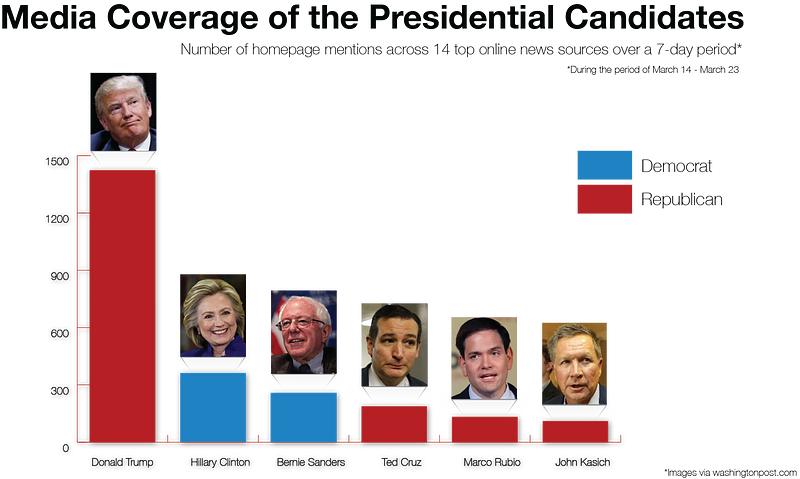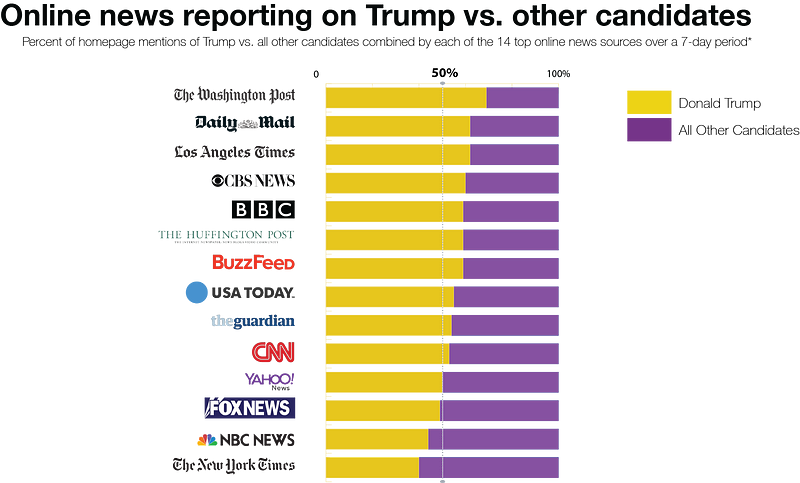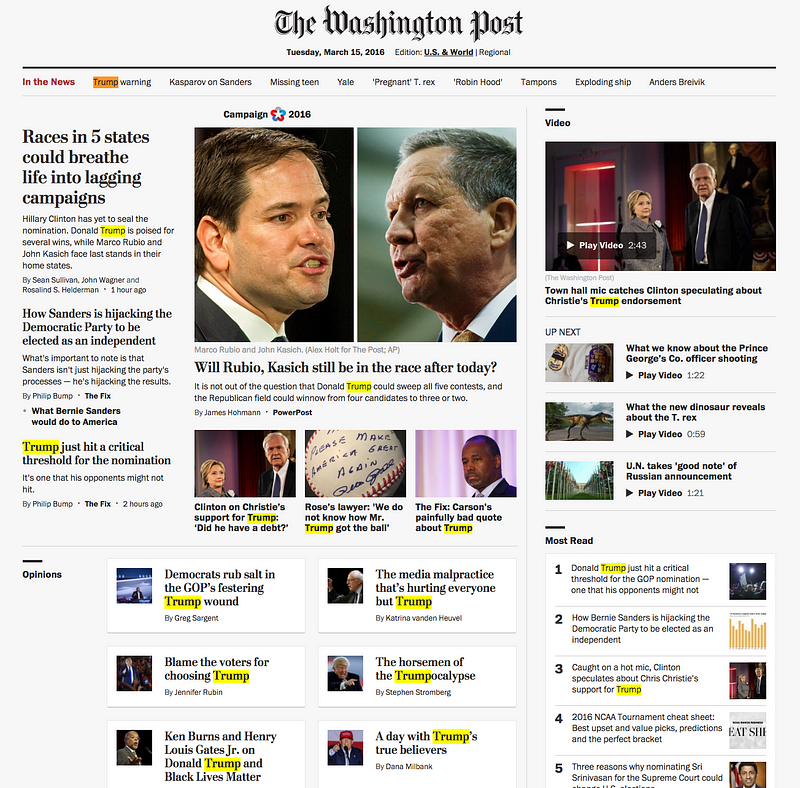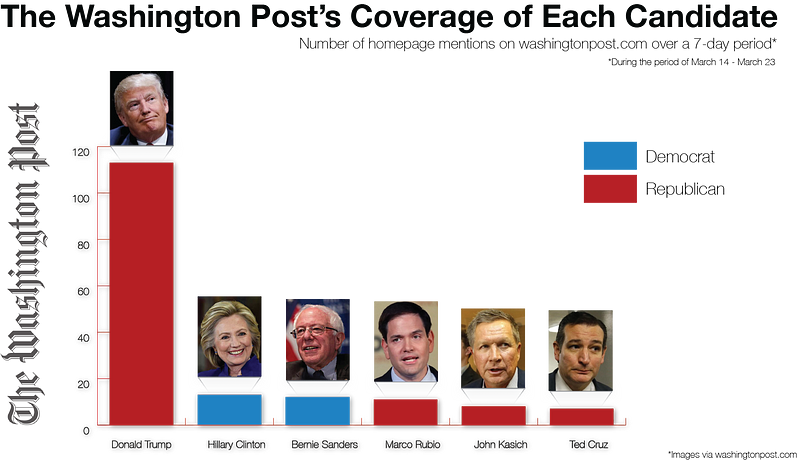This post by Ev Boyle was originally published on Medium.com.
Since announcing his presidential run last June, Donald Trump has made front page news almost every day. Even the most casual political observer can detect Trump’s enormous media advantage over his rivals. Earlier this month,the New York Times reported that Trump has earned close to $2 billion in free media across all platforms including television, print, online and social media — 2.5 times more than the $746 million earned by Hillary Clinton, and nearly as much as the 16 other candidates put together.
When the New York Times’ public editor Margaret Sullivan recentlyresponded to a reader’s complaint about how the Times’ homepage was devoted almost exclusively to Trump, it got me thinking: Just how much coverage are the top online news outlets devoting to Trump? And what publications are doing the best (and worst) job of balancing their presidential coverage?
Two weeks ago, our small team at the USC Annenberg Center on Communication Leadership and Policy set out to answer those questions. We spent an hour a day for 7 days (usually between 10am–12pm PDT) taking screenshots and counting mentions of Trump and all the other candidates on the homepages of 14 major news websites including the New York Times, CNN, Buzzfeed, and Fox News.[1] Here are a few things we found that surprised us:
1. Trump has received significantly more homepage coverage than all of the other candidates combined — During the 7 days in our sample, Trump’s name appeared in homepage headlines 1341 times. The next most covered candidate was Hillary Clinton with 361 mentions. Trump isn’t only outpacing his closest competitor by nearly 4 to 1 — his name appeared more often on major news websites than all other candidates combined (1341 for Trump, 1047 for everyone else).

2. The Washington Post’s coverage was the most skewed in favor of Trump — and the New York Times’ was the most balanced — Looking strictly at the volume of mentions, not content, nearly 70% of Washington Post homepage mentions of presidential candidates were for Trump. The remaining five candidates together accounted for only 30% of mentions.

If you believe the “all-press-is-good-press” philosophy that Trump ascribes to, volume is what matters. Ironically, Trump’s strategy for dominating the news cycle was the focus of a Washington Post column by Callum Borcher earlier this month, “Donald Trump is Laughing at the Media,” and another WaPo column by Eugene Robinson earlier this week, “No, the Media Didn’t Create Trump.”
While both Borcher and Robinson correctly argue that Trump is a master of manipulating the media, neither explains why The Washington Post would focus 70% of its homepage election coverage on Trump, while the New York Times would devote just 40%. Online news publications are making editorial decisions about how much to cover Trump, and how prominent that coverage should be. Given the wide variety of approaches across publications, these decisions can not be written off as “Trump made us do it.”

If you zoom in on just the Post’s homepage during our sampling period, the imbalance in coverage is staggering. Trump’s name appeared on the homepage 112 times across these 7 days, while Hillary Clinton’s name only appeared 13 times. That’s almost 10 times more mentions of Trump than any other single candidate.

3. The “Bernie Blackout” isn’t really a thing — At least not in our sample of online news (to be fair, the “blackout” originally referred to network news coverage). Based on the gap we found between Trump and everyone else, it’s more accurate to call it an “everyone but Trump” blackout. While Clinton’s name appeared more than Sanders’ over these 7 days, Bernie kept it close — and received more coverage than any of the other Republicans.
3. Trump’s advantage over his Republican rivals is tremendous — and Ted Cruz is the biggest loser — While Trump has a clear and substantial advantage over Hillary Clinton and Bernie Sanders in our sample, his Republican rivals are the real losers. While John Kasich’s relatively tepid electoral performance may not warrant a surge in media attention, Ted Cruzcontinues to win states and delegates while receiving a tiny fraction of Trump’s media coverage — 187 homepage mentions for Cruz compared to 1341 for Trump. (Interestingly, just as Kasich lost to the “ghost of Marco Rubio” in Arizona, he also lost to Rubio’s ghost in our media sample despite Rubio only being in the race for 2 of 7 days we analyzed.)
What now? This first dive into online news coverage was an experiment we launched out of curiosity. It’s an admittedly small sample, and while our methodology was consistent, it‘s not especially scientific. We’re open to keeping this project going in some way, e.g. by continuing to monitor these sources to see how coverage changes over the election year, or by analyzing not just the volume of coverage but also the content. If you think this research is interesting or valuable, or you have suggestions for how to improve and expand on it going forward, tweet me or our team at USC to let us know.
[1] We chose to focus on the top online news outlets because even in an age of social media, journalists and editors at these publications help to set the agenda by providing the source material for network and cable news, and social media.
Research assistance for this article was provided by USC graduate students Rebecca Mulqueen and Jane Yi. Beautiful charts courtesy of Skye Featherstone.